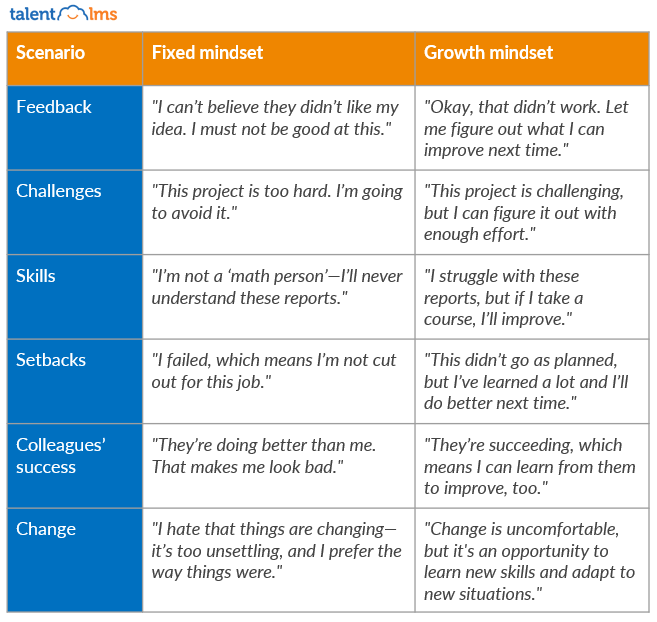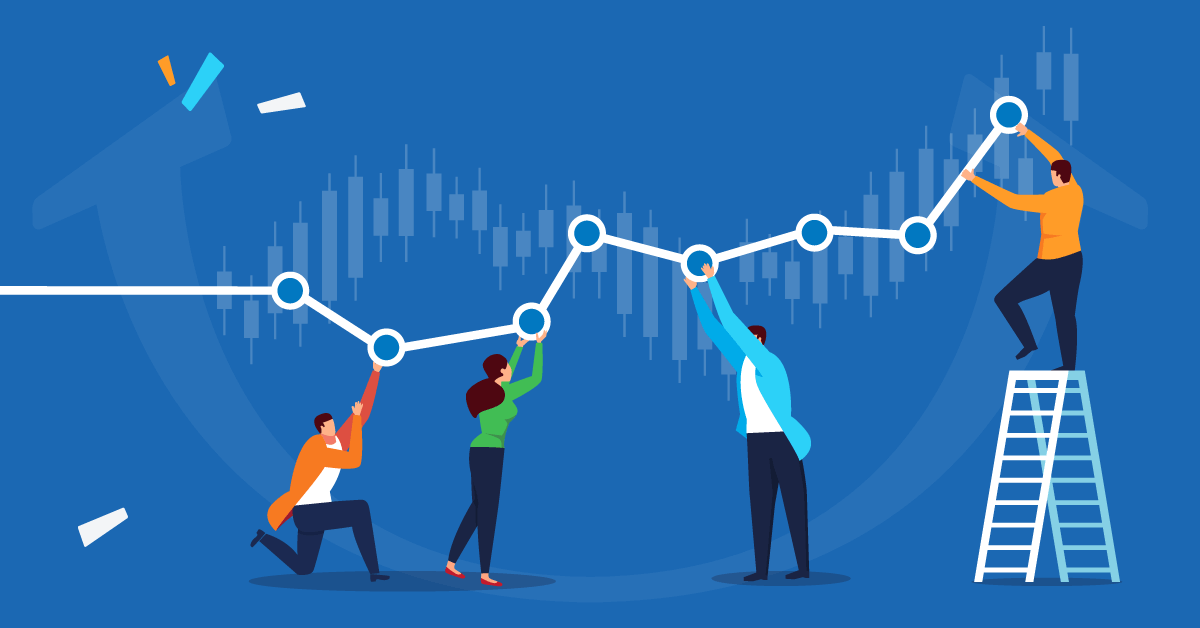Imagine unlocking a superpower that helps you embrace challenges, learn from setbacks, and continuously improve both personally and professionally. That’s the magic of a growth mindset. A mindset that turns failures into opportunities and ordinary workdays into a springboard for innovation and success.
While 87% of employees believe they have a growth mindset, only 45% think their company’s leadership consistently demonstrates one. In fact, 24% of employees say their leaders rarely or never show a growth mindset. The disconnect between leaders and employees highlights just how important it is to foster this mindset at every level of the organization.
Let’s explore real-life growth mindset examples, what a fixed mindset looks like, offer practical tips on cultivating this powerful mindset, and discover how to embed it into your organization’s DNA.
What you’ll find in this article:
- What is a growth mindset?
- 8 growth mindset examples
- How do people with a fixed mindset think?
- How to develop a growth mindset
- How to build a company-wide growth mindset
- Embrace the growth mindset and unlock your full potential
What is a growth mindset?
A growth mindset is considered a core approach to success. But what’s the growth mindset definition?
It was first introduced by psychologist Carol Dweck, and it’s the belief that intelligence and abilities aren’t fixed. Instead, they can be developed over time with effort, perseverance, and learning.
In simple terms, people with a growth mindset understand that no one is born with a limited set of talents or capabilities.
On the contrary, they support you can learn and grow over the course of your life. This contrasts with a fixed mindset, where individuals believe that abilities are predetermined, limiting what they think they can achieve.
So why is this important? Because in business, whether you’re managing a team, running a company, or trying to develop professionally, the mindset you foster directly impacts performance, innovation, and long-term growth.

8 growth mindset examples
What does a growth mindset look like in real-world situations? Here are some concrete growth mindset examples:
1. Embracing challenges
Let’s say you’re an HR manager who’s been asked to implement a completely new L&D program in your organization.
If you have a growth mindset, instead of feeling overwhelmed, you approach the challenging tasks as an opportunity to learn something new. You might research training software, seek advice from colleagues, or even take a course to boost your knowledge. You don’t shrink from the challenge. You embrace it, confident that you’ll grow along the way.
2. Learning from feedback
Feedback can be seen as a form of criticism that points out failures. But not for those with growth mindsets.
Here’s one of the most prominent growth mindset examples. Let’s take a business leader who recently rolled out a new company-wide initiative that didn’t achieve the desired results.
Instead of being defensive when given feedback (as people with fixed mindsets do), they actively seek it out. They meet with their team, ask what went wrong, and collect input on how they could have approached things differently. They don’t view the initiative as a failure; they see it as a learning process and experience.
3. Seeing effort as the path to mastery
Growth-minded professionals understand that effort is essential for improvement. Whether it’s mastering a new software tool, challenging previous knowledge, or engaging in upskilling and reskilling opportunities.
Take, for example, an employee who starts a new role and feels they aren’t meeting the job’s technical demands. Instead of giving up or asking to be reassigned, they invest in training on necessary skills, attend webinars, and practice until they improve.
Employees with a growth mindset understand that success isn’t based on talent alone but on dedication and practice.
Empower your people with a growth mindset and drive success
Offer hands-on training for upskilling and reskilling with TalentLMS.
The training platform that users consistently rank #1.
4. Persevering in the face of setbacks
In every career, there are setbacks.
Projects don’t go as planned. Deals fall through. Goals aren’t met. Someone with a growth mindset sees these “setbacks” as opportunities to learn and grow. They take time to analyze what went wrong, identify what they could have done differently, and apply those lessons to future situations.
Consider a marketing team that launches a campaign that didn’t generate the expected leads. A team with growth mindsets would dissect the campaign, look at the data, and figure out where improvements can be made.
Then, they’ll try again with new insights in hand, understanding that setbacks are a part of the learning process.
5. Actively seeking out learning opportunities
A key characteristic of people with a growth mindset is their hunger for knowledge. They’re always looking for ways to expand their skills and expertise. Even in areas outside their role.
One of the growth mindset examples that illustrates this is the following: A software engineer learning about project management to improve collaboration and communication with cross-functional teams.
This is a proactive approach to learning that helps people with a growth mindset gain a broader perspective. Plus, it makes them more valuable in their role and prepares them for future opportunities.
6. Viewing competition as motivation
Work environments can be rather competitive at times. It’s easy for individuals with a fixed mindset to see others’ successes as a threat. But someone with a growth mindset flips this script.
There are two salespeople in the same company. The first sees a colleague hitting high sales targets and feels threatened—how will they ever catch up? The second sees the colleague’s success as increased motivation. And begins to ask questions—what strategies are they using, what can I learn from their approach?
Viewing competition as a learning opportunity helps the second salesperson accelerate growth and improve their performance.
7. Pushing beyond job descriptions
A growth mindset means that people don’t limit themselves to the skill set of their job descriptions, as opposed to individuals with fixed mindsets. They look for ways to contribute beyond their role, developing new skills in the process.
For instance, a product manager might take the initiative to learn basic coding skills to communicate more effectively with developers. Or a customer service rep might offer to lead internal training on customer engagement strategies they’ve found successful.
8. Adapting to change
As the famous Heraclitus said, “The only constant in life is change.”
Embracing change is at the heart of a growth mindset, as it fuels the drive to learn, adapt, and evolve.
By welcoming new challenges and opportunities, we open ourselves to continuous growth and lifelong learning—both of which are essential for personal and professional success.
How do people with a fixed mindset think?
We’ve talked about what a growth mindset looks like. We went over growth mindset examples in real-life situations. But what about the other side of the coin?
According to TalentLMS’ report on the growth mindset in the workplace, people with a fixed mindset tend to avoid challenges because they fear failure. They believe that they aren’t able to improve, or they simply want to be good enough.
Plus, they view success as a reflection of inner natural talent rather than hard work. So, they tend to stick to what they know best.
Fixed mindset vs. Growth mindset: A side-by-side comparison
Let’s clearly define the differences between a growth and a fixed mindset. Here’s a quick breakdown:
People with growth mindsets
- Believe that abilities can be developed through dedication and hard work
- Embrace failure and view it as a chance to learn and grow
- Seek out challenges to develop new skills
- Are inspired by the success of others
- Aren’t fearful of change and adapt to new situations
- Embrace feedback and use it as a tool for self-improvement
People with fixed mindsets
- Believe inherent talents and abilities are static
- See failure as a reflection of inadequacy and engage in negative self-talk
- Avoid challenges to prevent the possibility of failure
- Feel threatened by others’ success
- Resist change, feeling uncomfortable with new situations or uncertainty
- Are resistant to feedback
Let’s take a closer look at how a growth and a fixed mindset can manifest in everyday work situations:

How to develop a growth mindset
Cultivating your own growth mindset doesn’t happen overnight.
It takes effort, consistency, and, guess what, a growth mindset! The good news is that you can develop growth mindsets within yourself and your organization.
How can both leaders and employees take actionable steps to develop a growth-oriented culture?
For leadership
88% of executives agree that a growth mindset is important for organizational success. Leadership sets the example for the entire organization. When leadership and management embrace a growth mindset, it trickles down to every level of the company.
Nikhil Arora, CEO of Epignosis, parent brand of TalentLMS, discusses the importance of leading by example and the importance of a growth mindset on TalentLMS’ podcast series, Keep It Simple, “Mastering a growth mindset and cultivating it in your workforce.” He highlights that 92% of employees will adopt a growth mindset if they see their leaders actively demonstrating it, according to TalentLMS’ report on the growth mindset in the workplace.

He also discusses how leaders and companies have the power to create an environment that fosters a growth mindset, but it’s not enough to just talk about growth—you need to actively measure and demonstrate it. For example, organizations should ask themselves if 20-25% of their revenue comes from something new they’ve implemented by the end of the year. This kind of tangible progress shows that growth is not just a concept but an actionable and measurable goal.
Here’s what leadership can do to nurture a growth mindset within their team:
Promote continuous learning
As Arora points out, “It’s easy to say you have a growth mindset, but do your employees see it? Leadership needs to not just talk the talk, but show it through vulnerability, experimentation, and leading by example.”
Continuous learning is crucial to fostering a growth mindset. But it needs to be modeled from the top. Employees should see their leaders actively engaging in learning. Whether that’s through workshops, taking up courses, reading books, or pursuing additional certifications. Employees can stay informed about the leadership’s activities through regular internal communications, newsletters, meetings, or updates shared on the company’s intranet.
As a leader, create opportunities for learning, encourage people to attend courses, and support their professional development.
Celebrate failures
One of the most effective ways to build a growth mindset is to normalize failure. Usually, failure is viewed negatively. Which discourages risk-taking and innovation. Instead, leadership should celebrate and recognize employee efforts. Even if they don’t always result in achieving success.
Arora shared a personal example where his previous company gave out “trophies for failures.” By turning mistakes into learning opportunities, they encouraged employees to step outside their comfort zones without the fear of repercussions.
Embrace vulnerability
Being vulnerable is a hallmark of growth-minded leadership. Leaders who are open about their own challenges, mistakes, and growth set an example for their teams.
When leaders show that they, too, are constantly learning and they know how to embrace challenges, it sends the message that it’s okay to make mistakes. As long as you learn from them and move forward.
Arora highlighted how important it is for leaders to admit their own limitations and actively seek improvement. By doing so, leaders foster an environment of trust and safety.
For employees
Employees themselves play a critical role in developing a growth mindset within an organization. Here’s how they can get started:
Seek out challenges
It’s easy for people to stick with what they know, but true growth comes from stepping outside your comfort zone.
Employees with a growth mindset should actively seek out challenges. This can involve volunteering for a project outside their area of expertise or learning a new skill.
Ask for feedback—and use it
Growth-minded employees don’t shy away from constructive feedback.
They actively seek it out, view it as a tool for improvement, and actually use it to become better. If you’re unsure of how you’re performing, ask your manager or colleagues for constructive feedback. Don’t take it personally, but see it as an opportunity to refine your skills.
Commit to lifelong learning
Growth doesn’t stop after completing formal education or training.
To succeed in the continuously evolving business world, people need to commit to lifelong learning. Be it through online courses, books, or attending industry conferences. Consistently building new skills helps people stay ahead of the curve.
Cultivate resilience
Setbacks are inevitable, but how people respond to them matters.
“If you get so fixated on ‘I need to come first, I need to get the medal,’ you will always try things in life that will get you the medal or the first place. And you will fear failure when you are not going to get those. And so you’re migrating towards a fixed mindset.” Arora supports.
Growth-minded employees view challenges and failures as learning opportunities. Not reasons to give up. When faced with a setback, reflect on what went wrong. And then how you can apply those lessons for future endeavors.
Meet TalentLibrary™
A growing collection of ready-made courses that cover the soft skills
your teams need for success at work
![]()

How to build a company-wide growth mindset
It’s one thing for individuals to adopt a growth mindset. But how do you scale that mentality across an entire organization? How do you break talent silos, ditch the fixed mindset culture, and encourage people to embrace a more positive attitude to achieve success?
Here are some key strategies to embed a growth mindset into your company culture:
Create a learning culture
A learning culture is one where continuous education, curiosity, and growth are valued at all levels of the organization.
This means offering employees the resources and opportunities they need to learn new skills. This can be in the form of formal training programs, access to online courses, or time set aside for personal development.
Investing in employee training software, like TalentLMS can be a game-changer. They allow employees to easily access relevant content and improve their skills at their own pace. By making learning accessible, you show employees that you value their growth and you’re willing to invest in their development.
Arora emphasizes that if you skill people and help them grow, you’re not just benefiting the individual, but you’re also directly impacting the company’s long-term success.
Promote psychological safety
To foster a growth mindset, it’s crucial to create a work environment where people feel safe to take risks, make mistakes, and learn from them.
This is known as psychological safety, and it’s much needed to encourage innovation and experimentation.
Interestingly, 64% of executives say that a growth mindset significantly improves productivity and performance, while 60% agree that it fosters a healthier workplace culture. This data reinforces how crucial psychological safety is for unlocking a team’s potential.
Employees must voice their ideas comfortably, even if these aren’t fully formed. People shouldn’t fear judgment or repercussions. Managers play an essential role here. They can promote psychological safety by being approachable, receptive to feedback, and encouraging open communication.
As Arora explains, when employees feel safe to experiment and fail, you create an environment where innovation thrives. It’s about making failure a stepping stone to improvement, not something to fear.
Offer personalized learning paths
Not all employees learn in the same way or at the same pace. One-size-fits-all training programs are unlikely to bring the best results.
Instead, offer personalized learning paths that cater to the needs and interests of each employee.
For instance, some employees might prefer hands-on learning, while others might thrive with self-paced online courses. The key is to offer options and tailor development plans that suit different learning styles.
The growth mindset is encouraged in a company culture that respects all needs.
Embrace the growth mindset and unlock your full potential
When organizations foster a culture of continuous learning, innovation, and experimentation, they can unlock their full potential and stay ahead of the game.
The growth mindset thinking isn’t just a personal philosophy. It’s a tool for driving business results.
Whether you’re a leader looking to take your company to new heights or an employee eager to grow professionally, adopting a growth mindset is key to achieving long-term success.
Now is the time to embrace and overcome challenges, learn from your failures, and never stop striving for improvement.



